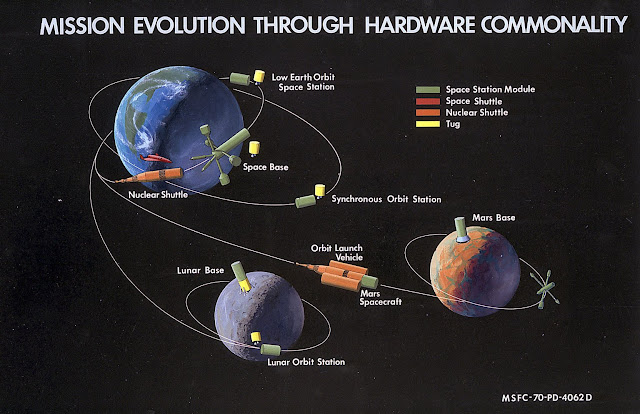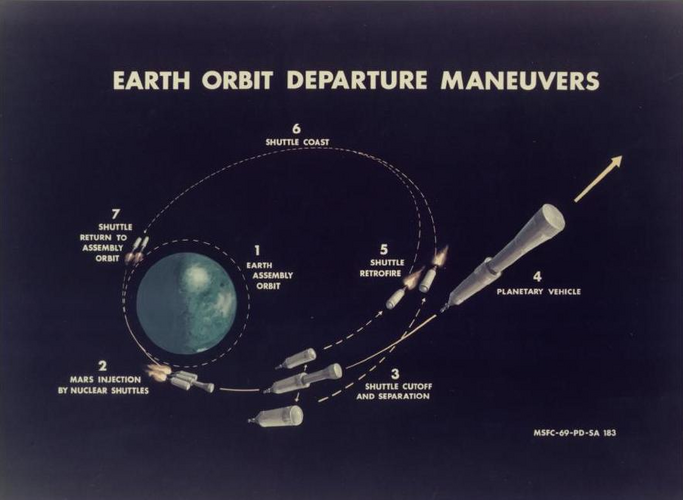Hi,
Similar to the Apollo Missions to the Moon, any planned trip to Mars could be viewed as large overall mission made up of many smaller individual tasks. For the Apollo missions this included issues like*;
- safely getting heavy loads into Earth orbit
- docking the command module to the lunar lander module
- exiting Earth orbit with the combined command module/lander assembly
- safely transitting from the Earth to the Moon
- entering luner orbit
- disengaging the lander from the command module
- safely descending in the lander to the Moons surface and executing a safe landing on the Moon
- doing whatever mission planned for the Astronauts that landed
- relaunching the upper stage of the lander into Lunar orbit
- redocking with the Command Module and transferring everyone back onboard
- exiting Lunar orbit
- safely transitting back from the Moon to the Earth
- re-entering Earth orbit
- jettisoning the lander and service modules
- safely deorbiting the Command module
- safely deploying the parachutes
- surviving rentry
- splashdown
Each of the steps above involved some degree of risks, and although the engineers and scientists could not necessarily identify all risks involved, there were likely mitigation strategies and contingency plans for if there were any number of issues during these steps. For instance, if something went wrong that either prevented docking with the Lunar Lander module or if there was an issue that prevented the combined Command, Service and Lander modules from safelty entring Lunar orbit, then there was always a possibility of aborting the restof the mission and returning to Earth, since the distances were not too far, as compared to the distance between the Earth and other planets, etc. Even so though, the accident on Apollo13 demonstrated that there could always be unforseen circumstances and evn the relatively short distance btween the Earth and the Moon could potentially be problematic if the life support systems were impacted.
Many years ago I had a video game called "Buzz Aldrin's Race Into Space" which was based on a board game called "Lift Off", and while these games simplified some issues and potentially chaned some stuff for playbilty purposes it was still a very good tool for demonstrating how a mission to the Moon could be viewed as a complex series of smaller steps. And in particular one of the big things the games stressed was that by conducting preliminary intermediary missions to test out some of these steps prior to doing a full mission to the Moon, experience could be gained and risks could likey be reduced or mitigated.
For the Apollo missions in particular, this included;
- Apollo 4 - an unmanned launch of the Saturn V rocket
- Apollo 5 - the first flight testof the Lunar module
- Apollo 6 - a final uncrewed qualification test for the Saturn V
- Apollo 7 - first crewed flight (with a 10 day duration)
- Apollo 8 - first Apollo flight around the Moon
- Apollo 9 - firstflight of the full Apollo spacecraft
- Apollo 10 - test of all components for the lunar mission,with the exception of an actuallanding
- Apollo 11 - first manned landing on the Moon
(source:
https://www.nasa.gov/the-apollo-program/)
A mission to Mars could similarly be broken into smaller such steps as outlined above for the Lunar mission, and I would likely expect that while some experiences from the Apollo missions could be used to mitigate the risks of some of the steps, I would still expect that there would likely be the need for a number of "preliminary intrmediate missions" to test out systems and procedures.
For a mission to Mars there are also additional considerations that might need to be addressed such as "timing" since the distance between the Earth and Mars varies as each planet revolves around the Sun in their respective orbits. As such, if a proposed Mars mission involved sending multiple rockets launched at different times, then some consideration would likely need to be given to when each rocket is launched and whether it would be desirable to ensure that the rockets with the "supplies for while on Mars" or the rocket with the "Lander" safely make it to Mars orbit prior toactually lanching the astronauts (or not).
Also, since the distances to Mars could make a journey just to the planet a matter of many months (perhaps up to 9 or so), then "off ramps" in the event of a potential mishap have the potential for being radically different than for a Lunar mission. Specifically, for example if we are assuming a mutli-rocket approach with one rocket carrying the crew,one carrying supplies for when on the planet and one carrying the lander, and if a one way mission to Mars may take up to 9 months will the rocket carrying the astronauts need to potentially need to carry 18months worth of supplies to allow the crew to return to Earth in the event of any issues that may prevent that rocket from rendezvousing with the other rockets at Mars?
As such, ifwe really want to be serious bout trying to assess whether a manned mission to Marscould have been done in the 1980s, a reasonable starting point might be to
- decide on what type of mission is being considered (ie will there only be one rocket to carry everything, or would a singlemission consist ofmultiple rockets carrying varous components)
- estimate what kind of new hardware may need to be developed (ie will the planned mission require the development of larger/heavier lift rockets, will it require the assembly of anything in Earth orbit (such as using smaller rockets to lift compenents into Earth orbit to assemble a craft that would make the transit to Mars), and/or willit require newer more advance life support and recycling systems, or advanced concepts for sheilding the carft and crew from long twrm exposur to radiation.
- estimate potential time frames for developing and new equipment required
- estimate whether any "intermediate test flights" are required for this new equipment
- etc
My suspicion is that if we use the landing of Apollo 11 on the Moon as a starting point for planning a mission to Mars the 11 years from 1969 to 1980 is likely no where near enough time to do everthing likelt needed,and even if we instead assume a period of 20 years (1969 to 1989) it still likely isn't enough.
* I'm sure that there are a lot of other steps as well,but this is just meant to show some of the main ones that entailed potential risks






















